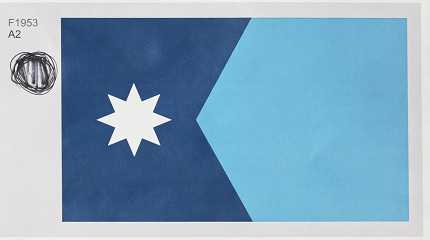
MINNEAPOLIS (AP) —
Minnesota’s new state flag should feature an eight-pointed North Star against a dark blue background shaped like the state, with a solid light blue field at the right, a special commission decided Tuesday as it picked a replacement for an older design that many Native Americans considered offensive.
The State Emblems Redesign Commission chose the final version on an 11-1 vote after finalizing a new state seal that depicts a loon, the state bird. Unless the Legislature rejects them, the new flag and seal will automatically become official April 1, 2024, when Minnesota observes Statehood Day.
The star echoes Minnesota’s state motto of “Star of the North.” The commission’s chairman, Luis Fitch, said that to him, the light blue represents the Mississippi River, “the most important river in the United States,” pointing to the North Star. But he acknowledged it could mean other things to other people. Symmetry and simplicity won out over other versions, including ones that included a green stripe for the state’s agricultural heritage.
The new flag is a revised version of a design submitted by Andrew Prekker, 24, of Luverne, who said he was grateful and amazed for the “rare privilege” of being able to contribute to state history.
“It’s an achievement that I hope brings a lot of unity and pride to our land, and I will hold that fact with great honor for the rest of my life,” Prekker said in a statement read to the commission. “It is my greatest hope that this new flag can finally represent our state and all of its people properly — that every Minnesotan of every background, including the Indigenous communities and tribal nations who’ve been historically excluded, can look up at our flag with pride and honor and see themselves within it.”
Minnesota’s current flag dates from 1957, an update from the 1893 original. It includes the current state seal, slightly tweaked from the 1858 original, which depicts a Native American riding off into the sunset while a white settler plows his field with his rifle leaning on a nearby stump. Critics say that imagery suggests the Indigenous people were defeated and going away, while whites won and were staying.
The state’s 11 recognized Dakota and Ojibwe tribes consider the previous design offensive. And experts in the study of flags — known as vexillology — say it’s overly complicated, that ideally a child should be able to draw a state flag.
The North American Vexillological Association ranks Minnesota’s old flag in 67th place out of 72 U.S. and Canadian state and provincial flags. Fitch said experts from the group rated the final choice an “A-plus.”
The commission included members of the state’s tribal and other communities of color. It settled last week on a new seal featuring a loon and the Dakota name for Minnesota: Mni Sóta Makoce, which can be translated as “where the water meets the sky.” On Tuesday, commissioners voted to increase the number of gold bars on the rim from 87 — one for each county — to 98 to include the 11 tribes.
It remains to be seen whether the new flag and seal become the symbols of unity that their supporters hope. Two Republican nonvoting members of the commission, Rep. Bjorn Olson and Sen. Steve Drazkowski, plan to submit a minority report to the Legislature. Olson said they believe the chosen seal violates the statute that created the commission, which is supposed to select a unifying symbol. With the Dakota name on the seal, Drazkowski said, it’s “raising one race above all the races of Minnesota.” Olson also said the process was too rushed, and that Minnesotans should vote on both the flag and seal next November.
But Democratic Secretary of State Steve Simon, a voting member, said his office studied the issue and reached a ‘“tentative conclusion” that such a vote would be unconstitutional because Minnesota law doesn’t allow for statewide initiatives and referendums.
Several other states also have been redesigning outdated flags. The Utah Legislature last winter approved a simplified design that still includes a beehive, a symbol of the prosperity and industriousness of its Mormon pioneers. Mississippi voters in 2020 chose a new flag with a magnolia to replace a Confederate-themed flag that was widely condemned as racist.
Other states considering simplifying their flags include Michigan,Illinois and Maine, where voters will decide next year whether to replace their current banner with a retro version featuring a simple pine tree and blue North Star.




